If you’ve been searching for the perfect gluten free biscuits recipe that actually tastes like real biscuits, your search ends here. These golden, fluffy buttermilk biscuits are so good that even your gluten-eating friends won’t believe they’re gluten-free.
Why This Is the Best Gluten Free Biscuits Recipe
After years of testing countless gluten free biscuits recipes, I’ve finally cracked the code. These aren’t your typical dense, crumbly gluten-free baked goods. These biscuits are:
- Light and fluffy with visible flaky layers
- Buttery and tender inside with a golden crispy top
- Ready in just 30 minutes with no rising time needed
- Easy to make even if you’re new to gluten-free baking
- Freezer-friendly so you can bake fresh biscuits anytime
The secret? The right gluten-free flour blend, cold butter, and a gentle folding technique that creates those coveted flaky layers.
Ingredients for Perfect Gluten Free Biscuits

Dry Ingredients:
- 2 cups gluten-free all-purpose flour (Pillsbury works best)
- ½ teaspoon xanthan gum (skip if your flour already has it)
- 1 tablespoon gluten-free baking powder
- 1 teaspoon salt
- 2 tablespoons granulated sugar
Wet Ingredients:
- 1 cup cold buttermilk (or make your own – see tips below)
- 1 large egg
- 6 tablespoons unsalted butter, very cold
For Dusting:
- 2 tablespoons gluten-free flour
How to Make Gluten Free Biscuits Step by Step
Step 1: Prep Your Ingredients (5 minutes)
Preheat your oven to 450°F. This high temperature is crucial for creating those puffy, golden biscuits.
Cut your butter into small cubes and pop them in the freezer for 10 minutes. Meanwhile, if you don’t have buttermilk, make your own by adding 1 tablespoon of white vinegar or lemon juice to 1 cup of milk. Let it sit for 5-10 minutes in the fridge.
Pro tip: Keep everything cold! Cold butter creates steam pockets when baking, which makes your gluten free biscuits fluffy and layered.
Step 2: Mix the Dry Ingredients
In a large bowl, whisk together your gluten-free flour, xanthan gum (if needed), baking powder, salt, and sugar. This ensures everything is evenly distributed.
Step 3: Cut in the Butter
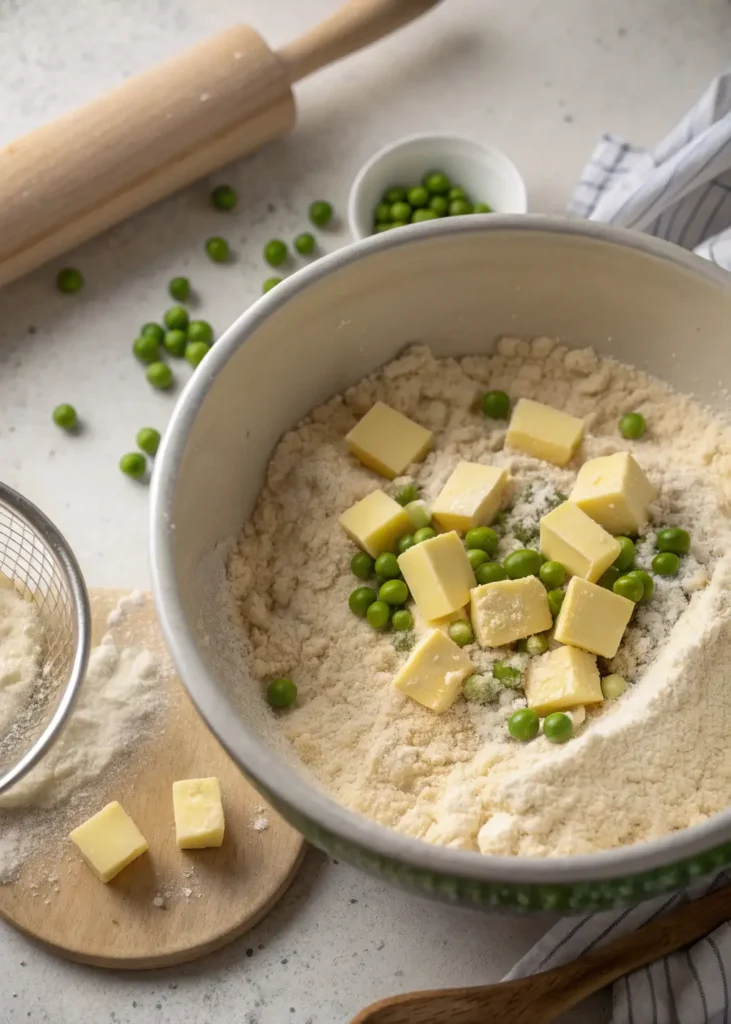
Take your super-cold butter and cut it into the flour mixture using a pastry cutter or fork. Work quickly so the butter stays cold. You want pea-sized pieces of butter throughout the mixture – this is what creates flaky layers in your gluten free biscuits.
Step 4: Add Wet Ingredients
Whisk your egg right into the cold buttermilk, then pour this mixture into your flour-butter combo. Stir gently until just combined. The dough will be sticky – that’s perfect! Don’t overmix or your biscuits will be tough.
Step 5: The Folding Technique (This Is Important!)
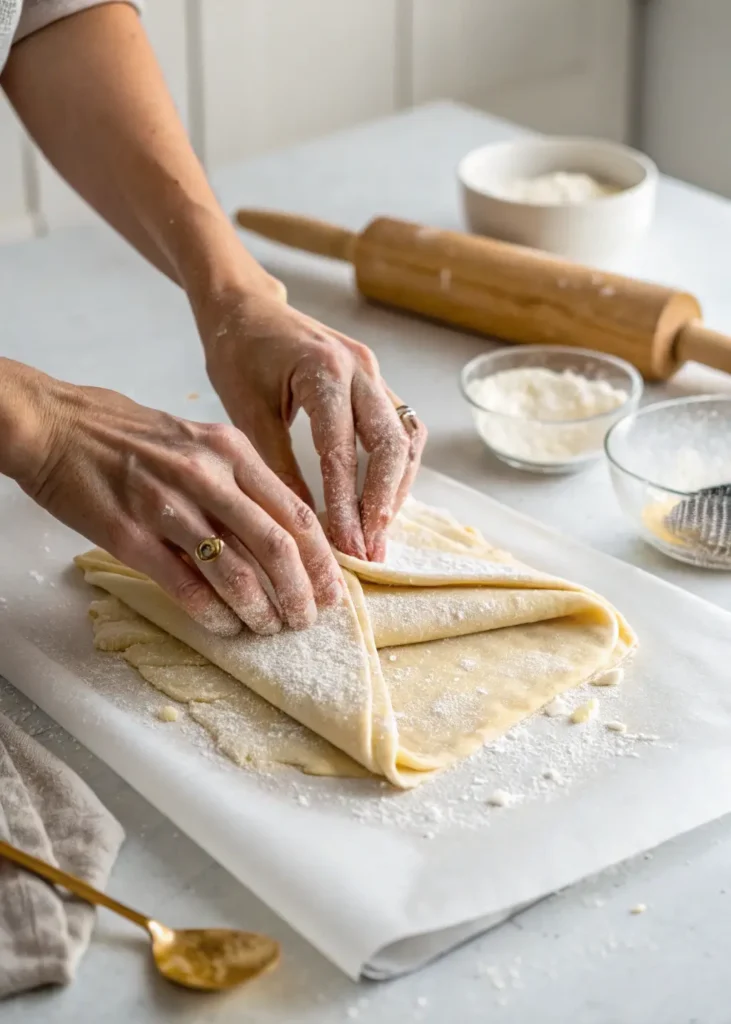
Sprinkle 1 tablespoon of flour onto a large piece of parchment paper. Turn your sticky dough out onto it and dust the top with another tablespoon of flour.
Here’s the secret: Don’t roll the dough! Instead, gently fold it in half, then fold it in half again. This creates layers without overworking the dough.
Shape the dough into a round about 7 inches wide and 1 inch thick. If you make it thinner, you’ll get flat, hard biscuits instead of fluffy ones.
Step 6: Cut and Bake
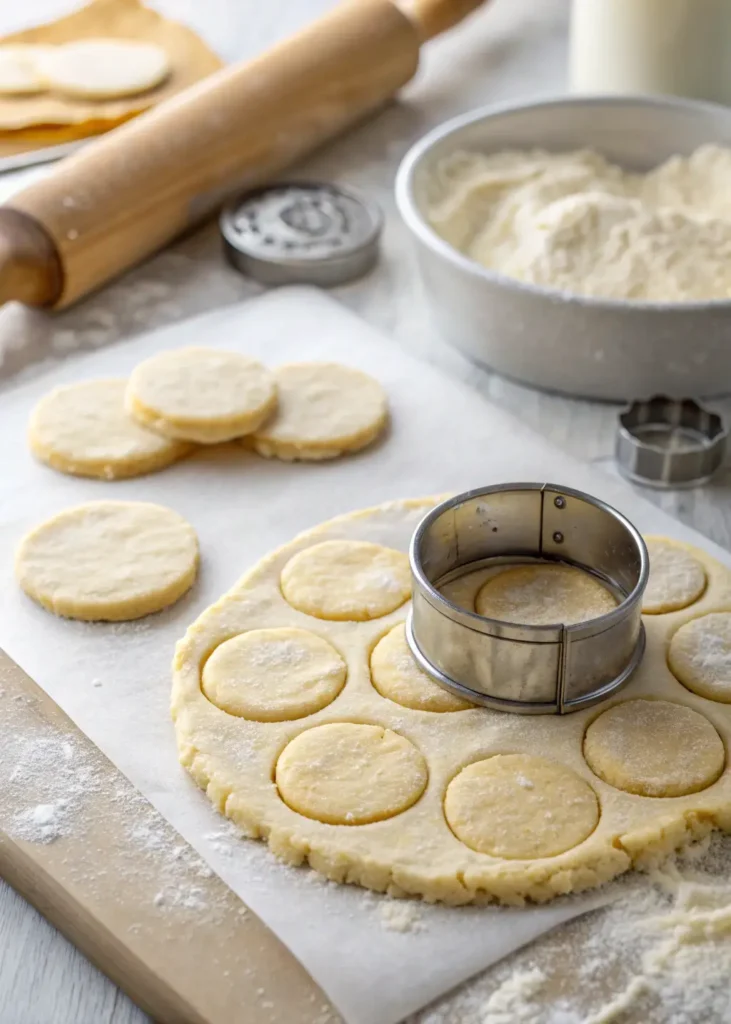
Use a 2-inch biscuit cutter (or a glass) to cut out your biscuits. Press straight down without twisting – twisting seals the edges and prevents them from rising properly.
Place the biscuits on a greased cast iron pan or baking sheet. You should get about 12 biscuits.
Bake for 15-20 minutes until the tops are golden brown. Start checking at 15 minutes since all ovens are different.
Step 7: The Finishing Touch
Brush the hot biscuits with melted butter as soon as they come out of the oven. This adds extra flavor and gives them a beautiful shine.
Expert Tips for the Best Gluten Free Biscuits
Choose the Right Flour
Not all gluten-free flours are created equal! For the fluffiest gluten free biscuits, use Pillsbury gluten-free flour. If you’re using Bob’s Red Mill, King Arthur, Great Value, or Pamela’s flour (which contain sorghum), you’ll need to add an extra ½ cup of flour to the recipe.
Measure Your Flour Correctly
Use the spoon-and-level method: spoon flour into your measuring cup, then level it off with a knife. Never scoop directly from the bag – this packs too much flour into the cup and makes dry, dense biscuits.
Keep Everything Cold
Cold ingredients are the secret to flaky gluten free biscuits. If your kitchen is warm, chill the flour too! The cold butter creates steam in the oven, which pushes the layers apart.
Don’t Overwork the Dough
Your dough should look shaggy and a bit messy. Overworking develops too much structure and creates tough biscuits. Mix just until combined, then stop!
Try This Freezing Hack
Make a double batch and freeze the unbaked biscuits on a tray. Once frozen, transfer them to a freezer bag. When you want fresh biscuits, bake them straight from frozen – just add 2-3 extra minutes to the baking time.
How to Serve Your Gluten Free Biscuits
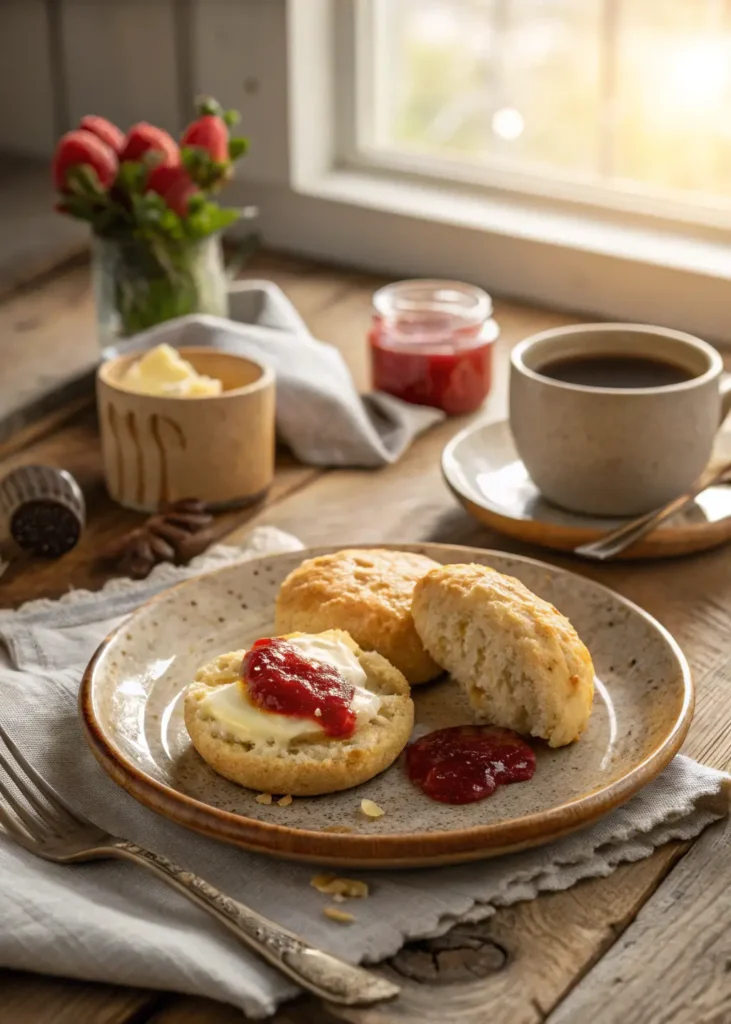
These versatile biscuits work for any meal:
- Breakfast: Split them open and fill with eggs, bacon, and cheese
- Lunch: Serve alongside soup or chili
- Dinner: Perfect with fried chicken or pot roast
- Dessert: Use them for strawberry shortcake
- Classic Southern: Top with sausage gravy for biscuits and gravy
Making Dairy-Free Gluten Free Biscuits
Need dairy-free? No problem! These gluten free biscuits work beautifully with substitutions:
- Replace butter with dairy-free butter (Smart Balance, Earth Balance, or Miyoko’s)
- Use dairy-free milk (almond, oat, or coconut) plus 1 tablespoon vinegar for buttermilk
- For egg-free, use Bob’s Red Mill Egg Replacer
The texture stays light and fluffy even with these swaps!
Storage and Make-Ahead Tips
Room Temperature: Store leftover gluten free biscuits in an airtight container for up to 2 days. Reheat in the oven or toaster oven to restore that fresh-baked texture.
Freezing Baked Biscuits: Freeze fully baked biscuits for up to 2 months. Reheat from frozen in a 350°F oven for 8-10 minutes.
Freezing Unbaked Biscuits: This is my favorite method! Flash freeze cut biscuits on a tray, then transfer to a freezer bag. Bake from frozen at 450°F for 18-22 minutes.
Troubleshooting Your Gluten Free Biscuits
Biscuits are flat and dense: You probably added too much flour or overworked the dough. Remember – the dough should be sticky!
Biscuits are gummy in the middle: They need more baking time. Every oven is different, so check them at 15 minutes but don’t be afraid to bake longer until golden.
Biscuits spread instead of rising up: Make sure your butter was cold enough, and don’t twist the biscuit cutter when cutting – this seals the edges.
Dough is too wet to handle: Different gluten-free flour blends absorb different amounts of liquid. Add flour 1 tablespoon at a time until you can handle the dough, but keep it as sticky as possible.
Why These Gluten Free Biscuits Work
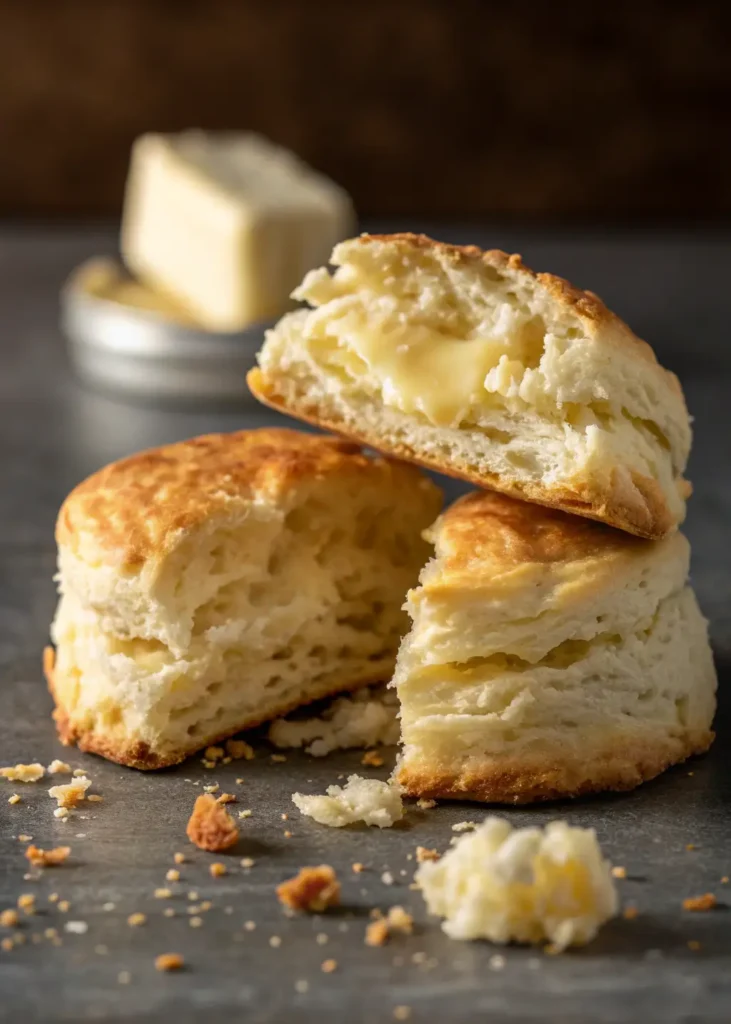
The magic behind these gluten free biscuits comes from:
- The right flour blend: Starches and rice flour mimic wheat flour’s texture
- Cold butter technique: Creates steam pockets for flaky layers
- Buttermilk’s acidity: Activates baking powder for extra lift
- Minimal handling: Prevents tough, dense texture
- High baking temperature: Sets the structure quickly while creating golden tops
Variations to Try
Once you’ve mastered the basic recipe, try these delicious variations:
- Cheddar Herb Biscuits: Add 1 cup shredded cheddar and 1 tablespoon fresh herbs
- Sweet Cinnamon Biscuits: Brush with butter and sprinkle with cinnamon sugar before baking
- Everything Bagel Biscuits: Top with everything bagel seasoning
- Jalapeño Cheddar: Mix in diced jalapeños and sharp cheddar
The Bottom Line on Gluten Free Biscuits
You don’t have to give up fluffy, buttery biscuits just because you’re gluten-free. With the right technique and ingredients, these gluten free biscuits taste just as good – if not better – than traditional biscuits.
The key is using quality gluten-free flour, keeping your ingredients cold, and handling the dough gently. Follow these tips, and you’ll have perfect gluten free biscuits every single time.
Ready to enjoy warm, flaky biscuits again? Get your ingredients together and give this recipe a try. Your taste buds (and your family) will thank you!
Frequently Asked Questions About Gluten Free Biscuits
Can I make gluten free biscuits without xanthan gum? Yes! If you’re allergic to xanthan gum, substitute with guar gum or psyllium husk powder in the same amount.
What’s the best gluten-free flour for biscuits? Pillsbury gluten-free all-purpose flour gives the fluffiest results. Avoid single-ingredient flours like almond flour or coconut flour – you need a proper blend.
Why are my gluten free biscuits crumbly? This usually means too much flour or not enough fat. Make sure you’re measuring correctly and using the full amount of butter.
Can I use this recipe for drop biscuits? Absolutely! If your dough is too sticky to cut, just scoop it onto the baking sheet with an ice cream scoop. They’ll be less uniform but just as delicious.
How do I know when gluten free biscuits are done? The tops should be golden brown and the biscuits should feel firm when lightly pressed. If they’re still soft and pale, give them a few more minutes.
Pin this recipe for later and share it with your gluten-free friends! Have you tried these gluten free biscuits? Leave a comment below and let me know how they turned out!
| Pin to Pinterest | Share on Facebook
Follow us On : Facebook and Pinterest


Leave a Reply